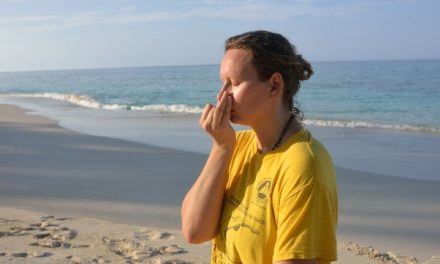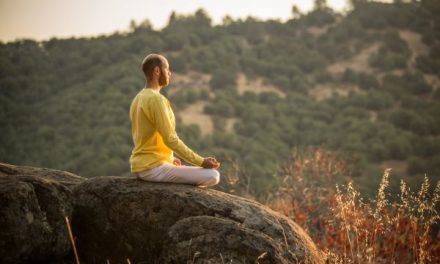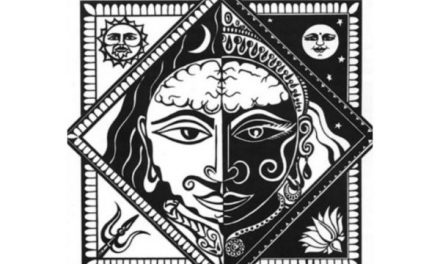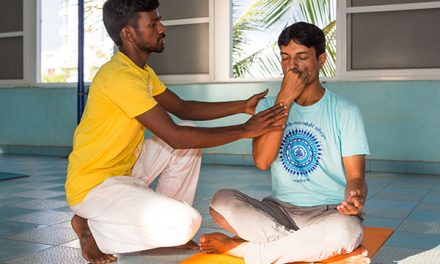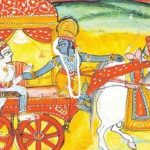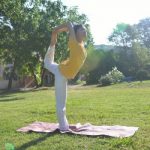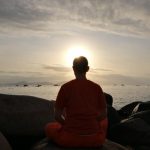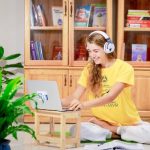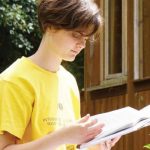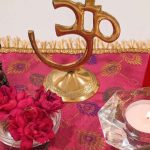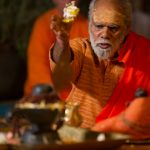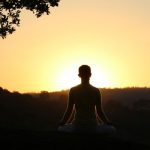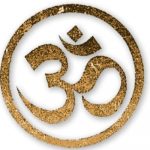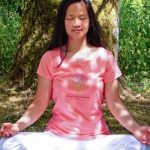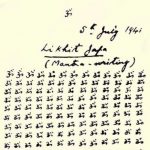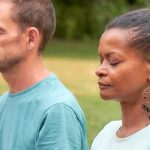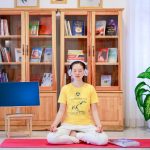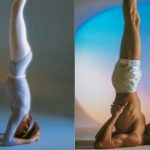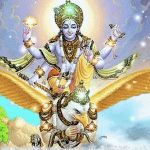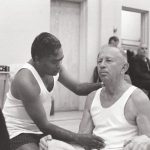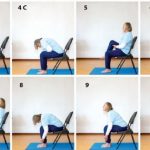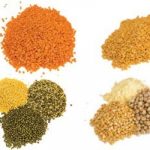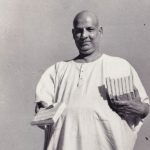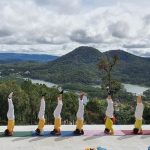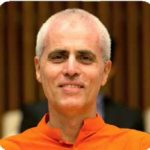 Nerve Impulse and Prana Impulse in your Daily Practice
Nerve Impulse and Prana Impulse in your Daily Practice
By Swami Sivadasananda
Nerve impulses are clearly defined; they start in a specific place and travel in one direction to another specific place. Nerve impulses can be categorised into:
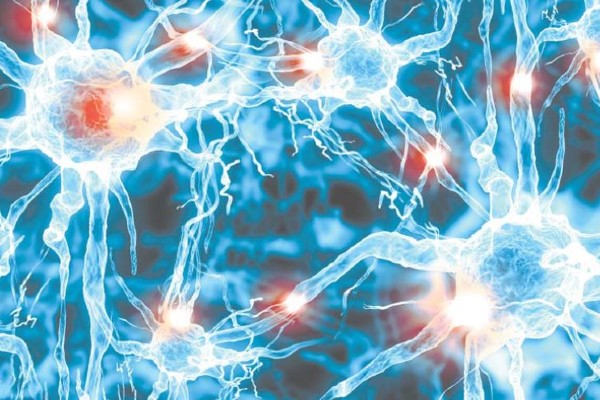 • Motor impulses (to muscles for example), which can be controlled voluntarily. Motor nerve impulses allow you to enter, remain or come out from an asana.
• Motor impulses (to muscles for example), which can be controlled voluntarily. Motor nerve impulses allow you to enter, remain or come out from an asana.
• Sensory impulses, which cannot all be perceived, depending on the level of wakefulness and awareness. In the asanas the main sensory impulse is the sense of touch. When you actually feel your muscles and joints, this is called proprioception.
• Sympathetic impulses, which create the fight and flight or stress scenario.
• Parasympathetic impulses, which help the body to rest and relax.
It is said that a direct control of the so-called involuntary nerve impulses (sympathetic and parasympathetic) is not possible. But the outcome of asana and pranayama practice is an effective balance between these two impulses. Yoga practice is both stimulating (sympathetic) and relaxing (parasympathetic). The word prana means life energy. Just like the physical nerve impulses, prana refers to active control and to the awareness of perceptions.
At the time when the word prana was created, the modern scientific observations of the nerve impulses were not available. But obviously the functions of motor, sensory, sympathetic and parasympathetic nerve impulses were all well known to the hatha yogis. How otherwise could they devise such a sophisticated exercise system which balances all the functions of the nervous system? Based on these considerations, one could say that the prana impulses include all nerve impulses.
What would then be a main difference between prana impulse and nerve impulse? Nerve impulses are controlled either by conscious awareness and will or by the subconscious mind. The level of prana impulses, which is different from the nerve impulses, can be controlled by both: the physical breath and mental processes such as visualisation, concentration and will power.
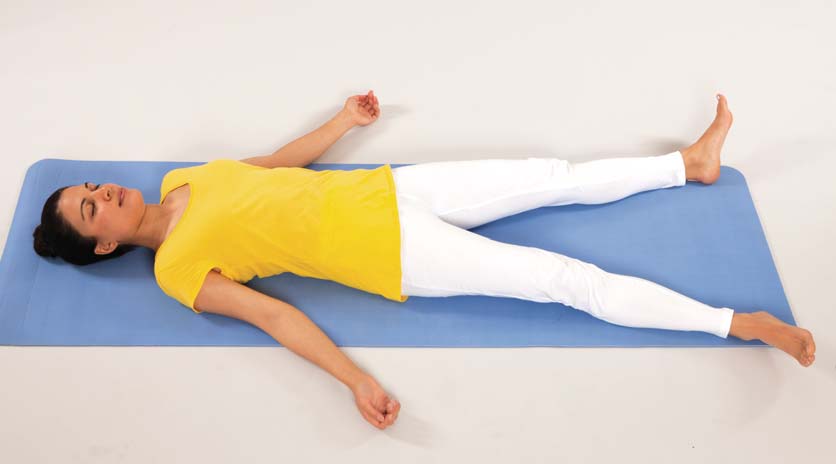
Final Relaxation (Savasana)
A Simple Example
When you lift one leg in Savasana, this movement is possible due to motor nerve impulses causing the contraction in various leg muscles. When you suddenly drop the leg, this is due to the sudden stopping of these nerve impulses. Incidentally you also inhale while lifting, hold the breath while the leg is up, and exhale when the leg is dropped.
This aspect can be considered the prana impulse. Which impulse is experienced more clearly in this liftingand- dropping-exercise, the nerve impulse or the prana impulse? As both of them happen simultaneously it is difficult to tell them apart. If you modify the exercise, the difference becomes quite obvious:
Adaptation No. 1
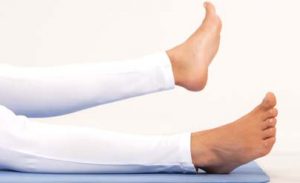
Tense & Release
Inhale and lift the leg. Then exhale, but continue keeping the leg up. Only when you have completed the exhalation, drop the leg. Here you first released the breath, which is the prana impulse, and then later you stopped the motor nerve impulse to the leg muscles, which caused the leg to drop.
Isn’t it surprising how much your motor capacity of holding the leg up against the gravity was weakened, once you had exhaled? This shows the difference between prana impulse and nerve impulse and how much the nerve impulse depends on the prana impulse.
Adaptation No. 2
Inhale and lift the leg. Keep holding the breath. Drop the leg without exhaling. Exhale only once you clearly feel the leg on the floor. You first released the motor nerve impulse to the leg muscles, and then you released the respiratory impulse, which is the prana impulse. It is surprising to see that the major sensation of release was only felt when you released the breath, the prana impulse.
Connection between the nerve impulse and the prana impulse
How is it possible that the motor nerve impulse which makes the diaphragm contract (inhalation) and relax (exhalation), can create the prana impulse, which allows very different levels of control and sensation in all body parts? A possible answer is that the phrenic nerve which supplies the motor impulses from the brain to the diaphragm has a ramification to the solar plexus.
The solar plexus has a wide range of functions from sensory to sympathetic and parasympathetic. What is difficult to explain in terms of the nervous system is how the effect of this prana impulse can either be very local or wide spread in the body, depending on the mental visualisation.
Importance of the prana impulse in your practice session
Swami Vishnudevananda advises a specific order for your practice session
• Pranayama (breathing exercises)
• Surya Namaskar (sun salute)
• 12 Basic Asanas with a choice of variations (there are around 100 variations to choose from), with a short relaxation after each asana
• Final relaxation with autosuggestion
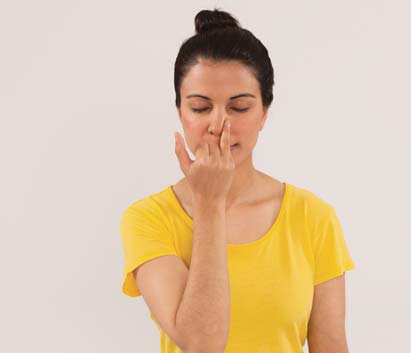
Alternate Nostril Breathing (Anuloma Viloma) Pranayama allows you to connect consciously to the prana impulse
Pranayama
It is advisable to begin with pranayama, as it allows you to connect again consciously to the prana impulse. The various exercises create a wave of relaxation with the exhalation, a wave of energy with the inhalation and lead to mental control of prana (concentration) when you hold the breath.
All these impulses are experienced while the body is remaining calm and motionless in the meditative sitting pose.
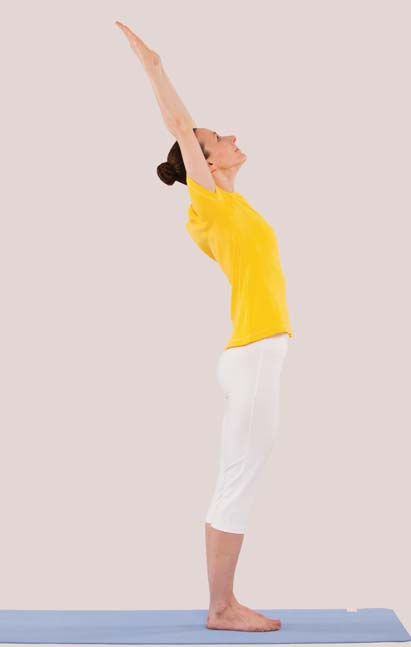
Sun Salutation (Surya Namaskar) position 2 Muscle effort increases as you are stretching the hands and the arms upwards
Surya Namaskar
In the sun salute respiratory and muscle control happen simultaneously. For example, when moving into position 2 (which is identical to position 11), your muscle effort increases as you are stretching the hands and the arms upwards, then lift the shoulder girdle, and control your leg muscles positioning the weight on your heels.
The further you move into the pose the stronger will be the muscle work. At the same time you are inhaling. The longer and further you reach upwards and backwards, the longer and deeper should be your effort to inhale, which is done by the diaphragm and the various respiratory muscles of the chest.
The moment you release the position, you also release the breath and start to exhale. This connection between the power of the breath and the power of muscle control can be felt in all the 12 poses of the sun salute. You can discover it quite easily with the following approach:
1 Start with four sun salutes (4 x 12 movements) and try to make only an intermediate muscle effort. Remain a bit below your maximum capacity of movement.
2 Now practice two sun salutes with exactly the same muscle effort, but reducing the depth of your breaths to a minimum. You will see how the same muscle effort results in a clearly inferior depth of movement.
3 Finally practice two sun salutes with a maximum depth and length of breath, while maintaining the same muscle effort. By contrast, your muscle control will feel like riding on top of an added energy wave – the prana impulse. Sun salute ensures that the mastery of the prana impulse which was gained from the pranayama exercises, is combined with the motor nerve impulses which allow the muscle control.
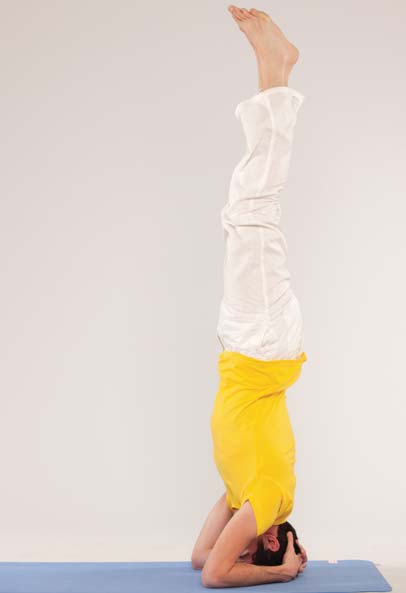
Sirsasana (Headstand) In order to remain in the asana there needs to be a fine tuning of the muscle tone
Asanas
Patanjali Maharishi states in the Raja Yoga Sutras, that the asana should be held firmly and comfortably at the same time, while the practitioner should focus on relaxation and meditate on the Infinite. In order to remain in the asana there needs to be a fine tuning of the muscle tone. This is comparatively easier in headstand, shoulderstand, plough, fish, sitting forward bend, spinal twist and standing forward bend.
Only the steadiness of the pose can be seen by the outer appearance. All the other aspects mentioned by Patanjali Maharishi can only be felt subjectively, and the best way to reach the perception is to focus on the breath: Each inhalation brings strength and firmness. Each exhalation brings relaxation and comfort. A first step towards the meditation on the Infinite is to focus on the expansion of energy.
As you continue observing the rhythmical interplay of inhalation/exhalation – firmness/comfort, this local energy imprint can expand into a more expanded aware ness of vital energy, sometimes flowing from the limbs to the spine and up to the head, sometimes from the abdomen out to all body parts, sometimes moving in a circular way through out the body. Each posture will show you its particular energy patterns. You only need to watch the polarity of inhalation and exhalation in relation to your body perception.
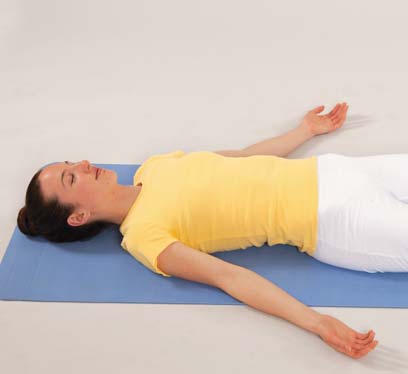
Final Relaxation (Savasana) The deepest level of physical relaxation depends on the combination of conscious abdominal breathing and auto suggestion
Final Relaxation
Here the conscious motor control is becoming very subtle. Deep muscle relaxation requires a greatly reduced flow of motor impulses to the muscles. This results in a very low muscle tone. Sensory awareness is stimulated by conscious abdominal breathing. This stimulates the sensory impulses in the solar plexus, which in turn increases proprioception or feeling all body parts from within the body.
The deepest level of physical relaxation depends on the combination of conscious abdominal breathing and auto – suggestion. When you focus on any part of the body with gentle breathing, you can feel each muscle in great detail, but the deepest level of relaxation comes when you actually do not feel the muscles any more at all. It is as if you had lost this part of the body.
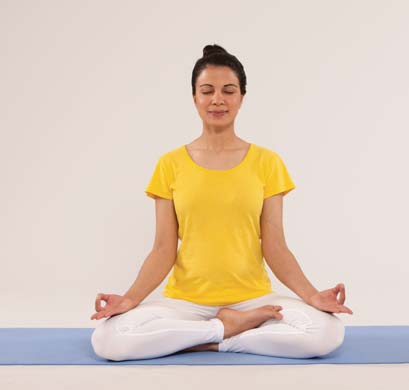
Meditation pose after final relaxation First you may sense some physical pulsations in various muscles in the legs, pelvis and along your spine
As the process of autosuggestion continues from the feet up to the head, this process of losing sensation of the body through deep relaxation continues. However, it does not feel like you are losing something, because the relaxation reduces the unnecessary amount of prana, which is spent in the body contraction. The deeper you relax, the more deeply you recharge your pranic battery. When the 15 minutes of final relaxation are completed you may sit quietly in any meditation pose for some time.
First you may sense some physical pulsations in various muscles in the legs, pelvis and along your spine. This is due to the increased motor impulses, which reactivate the muscle tone needed to keep the body upright. If you sit for a few minutes longer, you can focus again on the breath: watch the change of breath, when the inhalation joins the exhalation and when the exhalation joins the inhalation. These are the moments when the prana impulses flow.
You may now be able to feel the prana as a clearly different sensation than the nerve impulses flowing to your skeletal muscles. Finally try to bring the awareness of the prana impulse to the third eye centre between your eyebrows (Ajna Chakra). Here is the connection between prana impulse and the thought waves, through which the practice of meditation moves from the physical level to the mental level.
Swami Sivadasananda Yoga Acharya and a senior student of Swami Vishnudevananda, teaches workshops throughout the Sivananda Centres in Europe and Teachers’ Training Courses worldwide. email: [email protected]

